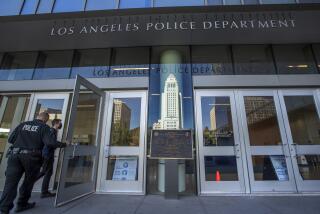LAPD Warns Officers About Technique in Hogtying Suspects : Police: Notice to personnel makes no changes in policy on using cord cuffs. But it notes that improper use of the restraint can cause death or serious injury.
- Share via
The Los Angeles Police Department--whose recent arrest of a Pasadena barber left him dead and sparked a federal civil rights investigation--has warned officers to take special care when hogtying suspects, reminding them that improper use of the technique “may cause serious injury and death.”
A notice was distributed to police officers last week and obtained by The Times on Monday. Although the notice does not change the department’s policies regarding cord cuffs, which are used to bind a suspect’s arms and legs, it implicitly acknowledges that many officers may never have learned the correct policies and therefore may be using dangerous techniques.
“Commanding officers and supervisors at every level of this organization are reminded to periodically discuss this topic at training days, roll calls, squad meetings, general information discussions and as part of civil liability training,” the notice states. It is signed by Deputy Chief Lawrence E. Fetters, the commanding officer of the department’s Human Resources Bureau.
Hogtying is just one of several techniques used by LAPD officers that have prompted confusion among the rank and file. Fetters’ notice adds that upcoming bulletins will update officers about other techniques that have left many officers puzzled. One of those, the so-called “swarm technique,” became a central issue in the state and federal trials of four police officers charged in connection with the beating of Rodney G. King.
Fetters was unavailable for comment about the notice or what had prompted it. But other officers said it appeared to grow out of a March incident in which Michael James Bryant, a Pasadena barber, died while in cord cuffs. Bryant was a well-liked figure in northwest Pasadena, and his death outraged many residents of that area.
Bryant, who had led officers on a car chase through several communities March 8, was apprehended in Highland Park and hogtied by LAPD officers. He later died after being placed face down in the back of a San Marino Police Department squad car.
Although placing Bryant face down in the car violated LAPD policies, it was unclear how many officers at the scene were aware of those rules. An updated memo on training guidelines for the use of cord cuffs was distributed to LAPD officers Oct. 30, 1992, warning officers against placing a suspect face down, since that can result in “positional asphyxia”--especially with overweight people. Bryant was 6 feet, 1 inch tall, and weighed 320 pounds.
Even though those guidelines had been distributed, it is unclear how many officers involved in Bryant’s arrest had received and understood them. Officers were not required to sign for the October notice.
As a result, some LAPD officers may have been unfamiliar with their department’s cord-cuffing procedures. The Pasadena and San Marino police who were also at the scene almost certainly did not know of the dangers of placing a suspect face down, officials said, since San Marino has never used cord cuffs and Pasadena has no policy against placing hogtied suspects face down.
The updated memo distributed last week directs officers to sign for the new guidelines to show that they have received and read them. Copies of a videotape on how to use the technique also are being distributed, and commanding officers are asked to watch that tape and see that their officers do so as well.
In addition to requiring that LAPD officers become familiar with the new policy, the notice distributed last week specifically informs LAPD officers of how to behave when turning a suspect over to another police agency.
“Officers are reminded that when utilizing cord cuff leg restraints, department policy must be followed,” the notice states. “This policy shall also be communicated to the employees of other agencies when custody of a prisoner is transferred to them.”
In Bryant’s case, that would have required LAPD officers to tell their Pasadena and San Marino counterparts about the prohibition against placing a suspect face down in the car.
The FBI opened a civil rights inquiry into Bryant’s death on April 26. The agency is investigating whether the officers used unreasonable force on Bryant during their arrest.
More to Read
Sign up for Essential California
The most important California stories and recommendations in your inbox every morning.
You may occasionally receive promotional content from the Los Angeles Times.











